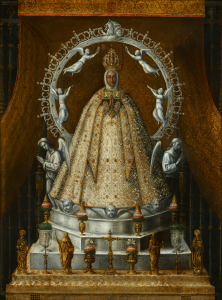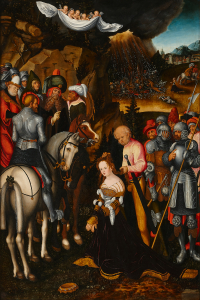Joseph Heintz de Jongere (ca. 1600 - after 1678)
Joseph Heintz de Jongere (ca. 1600 - after 1678)
The Temptation of Saint Anthony Abbot
Catalogue note
We are grateful to Prof. Dr. Bernard J.H. Aikema, University of Verona, who is specialized in the History of Painting and Drawing in Northern Italy between the 15th and the 18th century and who is an expert on the subject of the European Renaissance, for his kind assistance in cataloguing the present painting on basis of photographs.
This highly interesting painting is an emblematic work by the Augsburg born painter Joseph Heintz the Younger. In fact, Prof. Dr. Aikema states that this work is a very fine example within the oeuvre of Heintz II. The son of Emperor Rudolf II’s court painter, named Joseph as well, Joseph Heintz the Younger, who spent most of his career in Venice, developed a very personal style and specialised in two innovative genres: topographical view painting and capriccio's or capricci, the first often of special historical events, and the second, being even more typical for Heintz II; supernatural scenes of witchcraft, monstrous creatures and magic, vaguely in the manner of the influential Early Netherlandish artist Hieronymus Bosch. The present picture is a perfect example of the latter category, though within its kind definitely of a distinctly high quality.
The scene depicted forms a harmonious and balanced composition. In the centre, Saint Anthony Abbot is portrayed, wearing a back habit, keeping his gaze firmly focused on a book, possibly the Bible, in front of him, while clutching a crucifix in his left hand. The pious saint is being harassed by a satyr, who forcefully pulls the hood of his cloak and gets ready to stick the elderly monk with a bat. Though Saint Anthony does not let himself get distracted, the eye of the observer is drawn to the nude woman holding a mirror9, who forms a light focal point in the generally dark composition. Behind her stands a demon with the head of a goat, pouring out riches in front of the hermit saint. These supernatural manifestations try to persuade Anthony to lead a dissolute life, but because of his staunch faith he manages to resist these temptations. Not only the ground, but also the skies are filled with monsters and fantastic creatures, surrounded by flying spheres and lightening. This same pictorial device is employed by Heintz II in his Allegory of the Apocalypse, kept in the collection of the Kunsthistorisches Museum, Vienna.
This rather sinister scene is populated by various fantastic diabolical figures, caught conducting atrocious acts of cruelty. Interestingly, they appear to correspond to specific iconographic attributes associated with Saint Anthony Abbot. The swine in the lower right of the composition, which – just like Anthony – is being tormented by cruel monsters, is an iconographic attribute of both the saint and the Monastic Order named after him. The Monks of Saint Anthony cared for the city’s sick and in return they were allowed to let their pigs roam the streets freely. As such, there appears to be an interesting repetition of this iconographical theme within the depicted scene. In fact, Heintz II appears to have hidden a second iconographical repetition. Saint Anthony is venerated as the saint who gives protection from both human and animal epidemic diseases, notably the disease known as St. Anthony's Fire, or ‘erysipelas’. In the upper right corner a raging fire is consuming a city. The brightly burning fire not only underlines the transitiveness of worldly goods and vanity, but is also an iconographical attribute commonly associated with Anthony.
Artists biography and oeuvre
Joseph Heintz the Younger, also known as Giuseppe Enz(o) il Giovane, was probably born in Augsburg around the year 1600 as the son and pupil of the Swiss painter, draftsman and architect Joseph Heintz the Elder (1564-1609), who was court painter to the Holy Roman Emperor Rudolf II. Heintz II copied his father's paintings far into his own old age. Later he would become the step-son and apprentice of Matthäus Gundelach (c. 1566-1654), whom his widowed mother Regina Gretzinger married. Like Heintz the Elder, Gundelach was also court painter to Emperor Rudolf II. After the death of the Emperor in 1612 Gundelach remained in Prague in the service of Emperor Matthias. He left the court ca. 1615 for Stuttgart, where he was employed by the Duke of Württemberg for some time, after which he finally settled in Augsburg in 1617. Joseph Heintz the Younger was active in Augsburg from 1617 until 1625, after which time he travelled to Italy, residing in both Rome and Venice. Although Heintz II appears to have spent most of his time in Venice, he probably also spent long periods of time in Rome in the 1630s or 1640s, and before the year 1644 Pope Urban VIII made him a Knight of the Golden Spur. He would remain in Venice until his death in 1678, at the age of about 78. As such his long career spanned nearly seven decades.
Heintz distinguished himself from his contemporaries by his revolutionary paintings such as the present, inspired by the printed and painted output of Hieronymous Bosch, Pieter Brueghel the Elder and Jacques Callot. Heintz's oeuvre includes religious images, portraits, and – following the Emperor's taste – erotic mythological themes, such as the present composition. These works were at one time in high demand, but later on suffered an eclipse. In his works Heintz II investigates the pictorial questions of light and dark following the typical Italian canonical mode known as chiaroscuro; the use of bold contrasts in light which serves as a compositional devise. Almost all of his works display the interest he took in this technical matter.
To the modern observer, this scene has an almost blasphemous undertone. However, such images were not rare in Venice around the mid-seventeenth century. Heintz II was known for his Stregonerie – scenes depicting witchcraft or magical practices – a category of paintings which were eagerly collected in mid-seventeenth-century Venice. This can be gauged by the praise which this category of works received from the authoritative contemporary Venetian critic Marco Boschini (1602–1681) in his La carta del navegar pitoresco (The map of pictorial navigating), published in Venice in 1660. Heintz II must have been in contact with libertine circles in the city, such as the famous Accademia degli Incogniti, headed by the patrician Giovan Francesco Loredano, where blasphemous and even atheistic ideas were propagated in literature and in images by artists such as Pietro della Vecchia and, indeed, Joseph Heintz II. As such, the present painting is a highly interesting and important example of the Venetian libertine cultural manifestation of the mid seventeenth century.
Iconography and influence
In the third century AD a young Egyptian named Anthony sold all his possessions, gave the proceeds to the poor and went into the desert to lead a life of prayer and contemplation. His example attracted other men to the desert and eventually they formed the first Christian monastic community. The Life of St. Anthony, written by Anthony's contemporary St. Athanasius of Alexandria (298-373), spread the Saint's influence and inspired the formation of monastic communities throughout the Christian world.
The Temptation of Saint Anthony-theme is a popular subject in the history of art and literature, concerning the supernatural temptation reportedly faced by Saint Anthony the Great during his stay in the Egyptian desert, and became a well-known theme in Western culture. A popular medieval subject, included in the Golden Legend and other sources, shows Saint Anthony being tempted or assailed in the desert by demons in the form of monsters, whose temptations he resisted. In the present composition, the temptation is portrayed by the seductive nude woman and the riches placed in front of him. Traditionally, the saint is ferociously attacked by demons. Even though it is conventional to refer to such depiction as the Temptation of Saint Anthony, in the Golden Legend the demons attack him after he has overcome temptation.
An important pictorial source for Heintz II were the paintings by Bosch. No less than three works by this influential painter were kept in the Venetian Palazzo Ducale. As for the visual sources of Heintz’s bizarre figures, one has to think primarily of printed material, such as the engravings after Bosch by Pieter Brueghel or those by Giorgio Ghisi.
The present composition appears to be loosely based on a print by the French artist Jacques Callot (1592–1635) representing The Temptation of St. Anthony. For example, the large flying monster in the top centre of the present composition appears to follow Callot’s example, as does the burning architectural structure to the right. Prof. Dr. Aikema point to the influence of prints by Stefano della Bella (1610 – 1664).
Various reoccurring themes of motives employed by Heintz II can be found in The Temptation of Saint Anthony Abbot. In the present composition, the skies are filled with monsters and fantastic creatures, surrounded by flying spheres and lightening. Heintz II employed his same pictorial device in his Pluto comes from Tartarus, kept in the collection of the Městské Muzeum, Mariánské Lázně, Czech Republice. Heintz II also explored the theme of the constrained wild animal – in that case a bull – and that of fireworks in a painting depicting Giovedi Grasso during Carnival in Venice. The fantastic monsters strongly resemble those on A Witchcraft Scene attributed to to Heintz II, which also features little spidery, Bosch-like monsters. Since few of his works are dated, the paintings by Heintz II are difficult to date with great accuracy. However, the fine quality of the present very work indicates that is was conducted in the artist’s mature period and as such can be dated to the third quarter of the seventeenth century.
- Period
- ca. 1660
- Material
- oil on canvas
- Dimensions
- 63 x 71 cm
Global shipping available









